Matthew Aaron Browning's Blog
October 21, 2025
“Welcome to the Fan-mily!” My Trip to the Gilmore Girls Fan Festival
A crowd of hundreds is piled under an event tent on the town green.
“Who’s here for the first time?” asks Jennie Whitaker from the stage, minutes into her opening remarks, as she stares out at a sea of people. The response is louder than she anticipated. “Oh, I just assumed you’re all back again. I guess I should’ve started with, ‘Hi, I’m Jennie! Welcome to Fan Fest!”
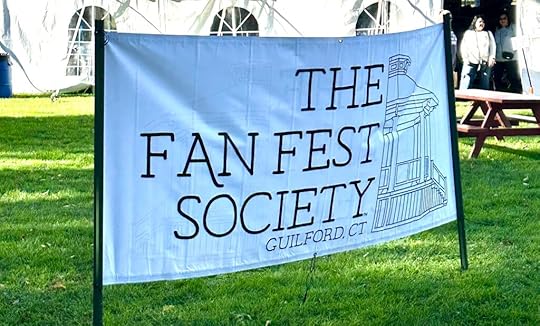
Jennie and her husband, Marcus, are the creators of The Fan Fest Society, an annual gathering of Gilmore Girls fans, cast and crew members that celebrated its tenth event in October.
“Gilmore Girls was simply the reason people began gathering…but it wasn’t the only thing everyone treasured from the event,” the event’s website states. “The community was real, Stars Hollow didn’t exist but our parallel universe actually did. People were more than just characters, they became friends. Well-written storylines were fun to explore. Talking about TV provided joy. And we decided to live the mantra, ‘if it brings you joy, you keep it.’ Hence, The Fan Fest Society.”
Every fall, hundreds of fans – not to mention a devoted roster of cast and crew members – gather in a New England town to celebrate all things Gilmore. This year and last, the lovely Guilford, Connecticut, with its central town green dotted with cafés, shops and restaurants, has stood in for Stars Hollow and welcomed more than 600 people into its small borders.
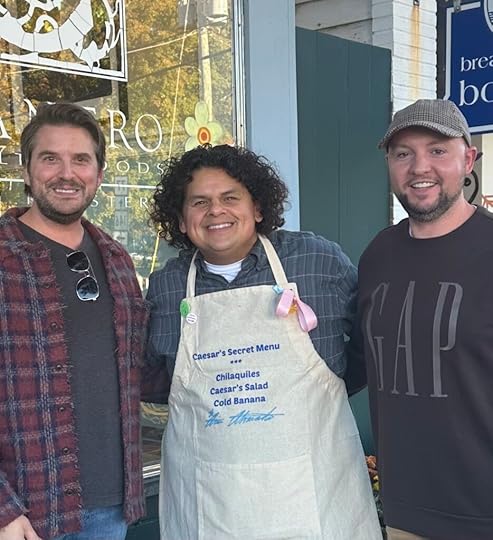 Aris Alvarado (“Caesar”)
Aris Alvarado (“Caesar”)I was a newbie. The event has been on my radar from the start, but I’d never managed to make the trek. With my book, Gilmore Girls Pop Culture Reference Guide, set for release in a few months, I decided to travel north this year come hell or high water. After buying my ticket, I reached out to Jennie to introduce myself. She was kind enough to offer me a slot on the schedule to discuss the book.
But book promotion was just an aspect of what I wanted to get out of my time at Fan Fest, because it is clear that this event forges deep bonds and lasting friendships – from all over the world and from very close to home. Among the first folks I met when entering the fandom were Claudia Schoder from Germany and Meghan Phillips, a fellow native West Virginian. Everyone is united by their love of this show, and they manifest those Stars Hollow vibes to anyone and everyone. It’s a welcoming and inclusive community of people from all walks of life who make the journey to Fan Fest. “Welcome to the fan-mily!” is a common greeting to new folks.
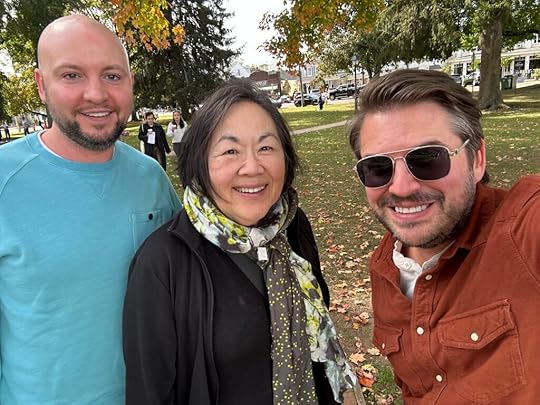 Emily Kuroda (“Mrs. Kim”)
Emily Kuroda (“Mrs. Kim”)That welcoming vibe was enveloping from the jump when we arrived on Thursday afternoon. It was evident that we were among friends, even if we hadn’t met them yet. My partner and I approached the registration table where none other than “Mrs. Kim” herself, Emily Kuroda, was there to welcome guests and assist the hardworking volunteers – her warmth and humor a far cry from that of her severe character. Aris Alvarado (“Caesar”) and Key Set Costumer Valerie Campbell were milling about chatting with fans. Outside the tent was photographer Nick Holmes (“Robert”) taking portraits of attendees. The energy was palpable for the early arrivers.
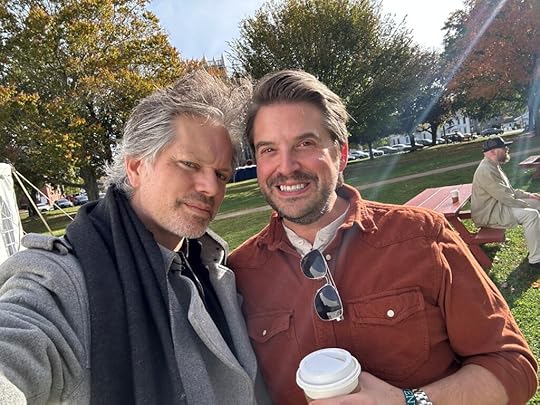 Nick Holmes (“Robert”)
Nick Holmes (“Robert”)
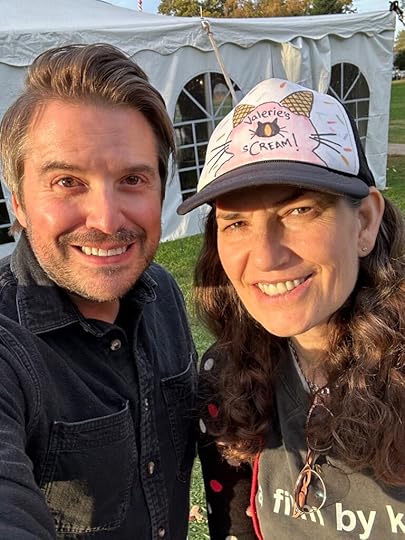 Key Set Costumer Valerie Campbell
Key Set Costumer Valerie CampbellBy Friday morning, the crowd at the registration area had tripled. I hit some early-morning sessions before slipping away for a very important appointment. My goal is to get a tattoo to commemorate each book I publish. Earlier this year, I got an elaborate and intricate portrait of The Golden Girls in honor of my last book. I thought what better time than while at Fan Fest to get my Gilmore-inspired art? Months ago, I began researching tattoo shops in the area and landed on Lucky Soul Tattoo in nearby New Haven. Owner Tracey Rose liked the idea of doing a show-related piece, and we began tossing around ideas.
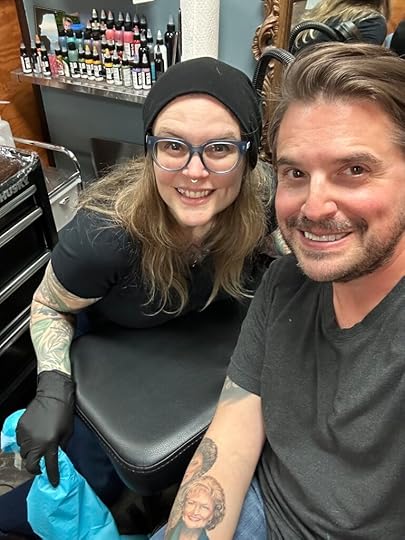 Tracey Rose, owner of Lucky Soul Tattoo in New Haven, CT.
Tracey Rose, owner of Lucky Soul Tattoo in New Haven, CT.I put feelers out in the Fan Fest’s Facebook group and had a running list of options – a firefly, the Luke’s Diner logo and an homage to the infamous “You Jump, I Jump, Jack” episode were all contenders. But I also wanted something different – something I wasn’t finding when searching Gilmore Girls tattoos online. Since it’s a book-themed sleeve I’m building on my arm, I settled on the logo of the town’s bookshop, Stars Hollow Books. After some slight modifications for sizing, Tracey got to work on the piece, which we placed on the inside of my wrist. It turned out beautifully. [People always ask if tattoos hurt. They don’t feel good, per se, but it’s a manageable discomfort. But Tracey did say, and she was correct, that the inner wrist is a little spicy.]
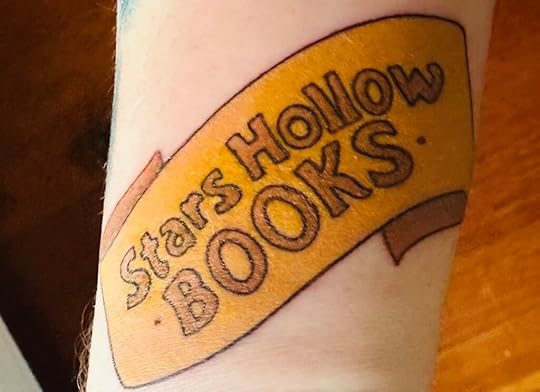
Freshly inked, we headed back to Guilford for the afternoon and evening festivities (after a stop for some famous New Haven pizza at Modern – the source of the town’s best pizza being hotly debated at the tattoo shop). The agenda at Fan Fest is a blend of cast/crew meet-and-greets, special topic sessions like trivia games, and unique offerings like the 90-minute panel with the one and only Kelly Bishop (“Emily Gilmore”), arguably the fest’s biggest “get” in its 10-year history.
Later in the evenings are the big draws like cast and crew panels, a singalong led by Kathleen Wilhoite (“Liz Danes”), and a costume contest. My go at Luke was technically accurate but outmatched by more creative and elaborate offerings. I lost the “Business Owners of Stars Hollow” category to a couple dressed as Jackson and his zucchini. Oh, well. Personally, I think the dude dressed as candy shoppe Taylor was robbed!
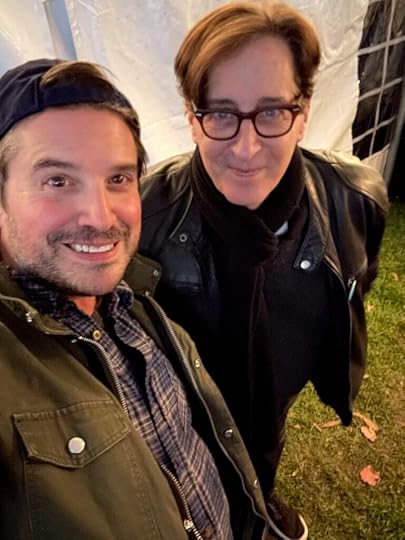 In my Luke attire with writer/producer Stan Zimmerman.
In my Luke attire with writer/producer Stan Zimmerman.My favorite evening event was The Coffee Monologues, spearheaded by writer/producer and friend Stan Zimmerman, who I first met at a Golden Girls convention a few years ago and later welcomed to my bookshop when he was touring with his memoir, From Golden to Gilmore. Stan recruits attending cast members to perform monologues from the show as other characters. This year, Aris Alvarado read as Rory, Nick Holmes as Lorelai, and dialogue coach/featured extra George Bell as Emily. It made for a hilarious alternate-reality version of the show. Lastly, the nights are capped off with events like karaoke and dance parties, but my old self was ready for bed before the lights went down on those gatherings.
 Discussing Gilmore Girls Pop Culture Reference Guide with publicist Anthony Pomes.
Discussing Gilmore Girls Pop Culture Reference Guide with publicist Anthony Pomes.And as for my session? Coincidentally, my publisher, Lyons Press, is located less than half an hour from Guilford, and my wonderful publicist, Anthony Pomes, agreed to come along and help facilitate an hour we ultimately called Gilmore Girls Pop Culture Palooza. Anthony and I took the stage in the main tent on Saturday afternoon to discuss Gilmore Girls Pop Culture Reference Guide and play some trivia based on pop culture references from the show. We pulled up players from the audience for a couple rounds – some players doing better than others but everyone having fun…I think! Destiny’s Child and Charo they knew right away. Petticoat Junction and cat-lady Jocelyn Wildenstein stumped ‘em. It was a fun hour that seemed to be well received by folks and hopefully generated a little buzz for the upcoming book.
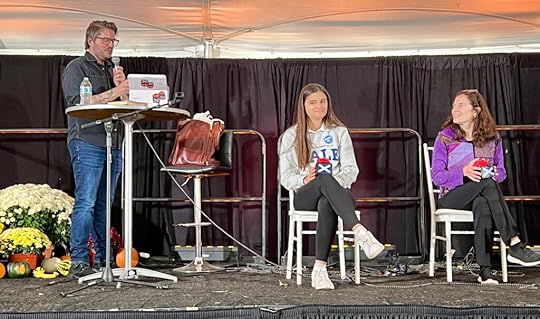 Playing “Pop Culture Palooza.”
Playing “Pop Culture Palooza.”It’s a tricky balance attending this kind of event with something to promote, because I didn’t want it to look like I’m only there for that purpose. What I wanted more than anything from this event is to better immerse myself into a fandom that I’ve long been a part of but had never experienced to this degree in person. I’m no stranger to TV show fandom and the strong bonds a mutual love of a show can create. I was part of The Golden Girls online fandom way back in the ’90s and became the torchbearer for its spinoff show, Empty Nest, so much so that I eventually found myself hosting reunion panels at events and becoming friends with members of the cast. I experienced The Golden Girls fandom’s lasting effects at the Golden-Con events in Chicago, but I would say the love and devotion is perhaps even more palpable in the Gilmore Girls world. I met people this weekend that I’m happy to know and look forward to getting to know even better. Everyone with whom I interacted was eager to chat, trade tokens, share stories, and become friends.
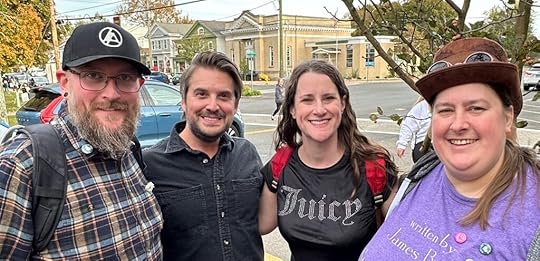 Fellow fans and friends Sean, Meghan (a WV native!) and Claudia.
Fellow fans and friends Sean, Meghan (a WV native!) and Claudia.My first-ever Fan Fest Society was a blast. Thank you Jennie and Marcus for your devotion to this event and all your hard work – and for letting me be a small part of it. Also thanks to the many volunteers and others working behind the scenes, to Will the sound guy for making us sound good on the stage, to the fan ambassadors for your commitment, to Guilford for making us feel welcome, and to the show’s cast and crew members who give so tirelessly of your time and energy to make every fan feel special.
A recent Us Weekly story called Gilmore Girls “a show, a lifestyle, and a religion.” After a weekend in Stars Hollow – err, Guilford – I’d call that an accurate description. I’m happy to say that, where this show leads, I will follow.
November 28, 2023
Tanya Tucker Albums Ranked
That record did indeed revive Tucker’s career, winning her a pair of Grammys – her first in a 50-year career – and kickstarting a long-awaited second (or third or fourth?) act for the country legend. The momentum has continued through the release of an acclaimed documentary, a recent celebration alongside Patti Labelle on CMT’s Smashing Glass, a second critically adored record, and induction into the Country Music Hall of Fame. So it seemed like a good time to revisit and revise this list, see if my rankings still hold, and figure out where her two latest albums land.
With a career spanning five decades, Tucker burst onto the country music scene in 1972 as a 13-year-old with a husky voice and a penchant for hard-living story songs and sexually suggestive material. She has released more than 30 studio, live, and compilation albums; notched 10 #1 hits and 39 Top Ten singles; scored 13 Grammy nominations (and finally two wins), and countless CMA and ACM awards and nominations; written two books; released an exercise video; performed during the Super Bowl half-time show; launched lines of salsa, clothing, dolls, and (presently) tequila; and starred in her own reality TV show.
Long one of country music’s most skillful vocal interpreters and enigmatic figures, Tucker is as well known for her music as she is for her controversial personal life. One of the first artists in country music – if not the first – to succeed with an unapologetically sexualized image, Tucker has been called everything from the Madonna of country music to the female Elvis. The Texas Tornado’s career has certainly seen its share of highs and lows over the years: a greatest hits package and a Rolling Stone cover by age 15; a cocaine-fueled romance with a twice-her-age and married Glen Campbell at 22; a descent into the Los Angeles party scene and an ill-fated foray into rock and roll; an extended stint in rehab and a country comeback in her late 20s that led to chart topping singles, more Grammy nominations, and a CMA Female Vocalist award; a surprise pregnancy that inspired a “Honk if you’re the father of Tanya Tucker’s baby” radio campaign; and health issues that left her voice permanently altered. Through it all, Tucker has persevered. “Just call me Tanya Timex,” she once said. “I take a lickin’ and keep on tickin’.”
Now, thanks to the career resurgence engineered by Carlile and Jennings, Tucker is finally being embraced and celebrated as the “outlaw country” music legend she is. With a 50-year career to sort through, let’s take a look at Tanya Tucker’s sizable discography, ranking her studio albums (numerous compilations and live albums omitted).
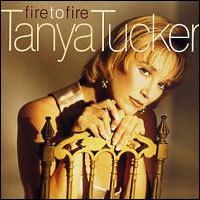
27. Fire to Fire (1995) – After a long, successful run with producer Jerry Crutchfield – a run which included Tucker’s mid-80s resurgence and 90s reign as one of country’s contemporary leading ladies – this 1995 offering barely manages to catch fire and marked the end of the Tucker-Crutchfield recording relationship. Lead single “Between the Two of Them” is another homage to the longevity of love, a la 1992’s beloved “Two Sparrows in a Hurricane,” only much less interesting. The tune stalled at #27 on the charts. Follow-up single “Find Out What’s Happenin’” – a fun toe-tapper originally recorded by Bobby Bare – fared even less well, barely cracking the Top 40, while the title cut, a duet with Willie Nelson, squanders the talent of the two legends. The record isn’t without its moments, though. “I Bet She Knows” is classic midtempo, sultry Tucker; “I’ll Take Today” is a sweet ode to love; and the Delbert McClinton-penned “The Love You Gave to Me” is a solid slice of gospel-tinged country. Tanya has called it one of her favorites from the Crutchfield era, but it didn’t create much fire when it was released.
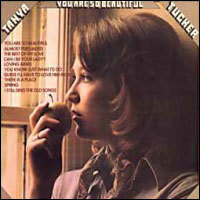
26. You Are So Beautiful (1977) – Technically a compilation album, this collection was released by Columbia Records in 1977, well after Tucker had moved on to MCA, and pulls together unreleased songs she cut while at the label. Credible takes include the title track (which reached #40 on the country charts), a cover of the Eagles’ “Best of My Love,” and the story song “Spring,” which has remained part of Tucker’s touring repertoire. Other than those standouts, there’s not much to remember about this one. Peaking at #44, the record was Tucker’s lowest-charting album up to that point.

25. Should I Do It (1981) – Tucker’s final studio album for MCA (a live album came out a year later) continues the country-pop direction of its predecessor, Dreamlovers. Tucker’s then-lover Glen Campbell, who appeared twice on the previous album, turns up again for the pair’s final recorded duet, “Shoulder to Shoulder,” while Emmylou Harris lends backing vocals to “Stormy Weather.” Typically not much of a writer, Tucker scores a rare songwriting credit with the single “Rodeo Girls,” which peaked at #83 on the charts. The only other song to chart was the title cut, which only reached #50 (although The Pointer Sisters would fare better with the tune a year later on the pop charts). The record stalled at #48, and Tucker left MCA soon after.
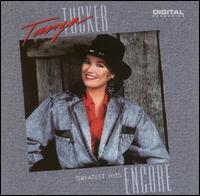
24. Greatest Hits Encore (1990) – This quasi-studio album is a collection of re-recordings of some of Tucker’s biggest hits from her years as a child star. At the time, Capitol Records found itself with a roster of artists who’d had some of their biggest hits on other labels, sparking a series of albums like this one from the likes of Ronnie Milsap and Eddie Rabbitt. The low ranking isn’t because the record is unenjoyable or poorly produced. It’s simply because this material can be heard elsewhere in its original – and less polished – form. Since most of these songs had been recorded when Tucker was a teen, it’s nice to hear her take on classics like “Delta Dawn” and “Blood Red and Going Down” as an adult, but the original versions pack more of a punch.

23. Dreamlovers (1980) – After a mixed-results foray into a more rock-based sound on her two previous records, TNT and Tear Me Apart, Tucker returned to Nashville – and producer Jerry Crutchfield – for this more country-pop oriented affair, although the pop-leaning production on tunes like “I’ve Got Somebody” keep it from being a true return to country form. Oh, and speaking of affairs, Dreamlovers came during the height of her romance with Campbell, whose shirt she’s sporting on the album’s cover. The pair duets on two tracks: “My Song” and the Bobby Darin hit “Dream Lover.” The latter – a solid cover – was released as a single but stalled at #59. The ballad “Love Knows We Tried” was also released to radio but barely cracked the Top 40. The album’s most memorable song, and highest-charting single at #4, is the Deborah Allen/Rafe VanHoy tune “Can I See You Tonight,” which Tucker still performs today.
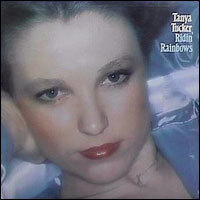
22. Ridin’ Rainbows (1977) – Following the experimental Here’s Some Love album the previous year, Ridin’ Rainbows continues to bridge pop production with Tucker’s country twang. Hit singles “Dancing the Night Away” (#16), “It’s a Cowboy Lovin’ Night” (#7), and the title track (#12) keep things country, while the rockin’ “Wait ‘Til Daddy Finds Out” brings out the trademark Tucker grit.
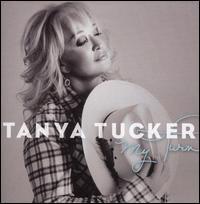
21. My Turn (2009) – While I’m Livin’ was hailed as Tucker’s first new album in 17 years when it dropped in 2019, but while that made a more interesting headline, it was actually her first new album of original material to be released since 2002’s Tanya. Tucker’s last record before returning in 2019 was actually this 2009 collection of covers in which she tackles country standards previously sung by men. Always one to run with the boys, so to speak, Tucker’s rough and tumble voice feels at ease on such classics as “Is Anybody Goin’ to San Antone,” “Oh Lonesome Me,” and “Lovesick Blues,” while Jim Lauderdale lends a hand on lead single “Love’s Gonna Live Here.” Tucker has said she’d love to do an entire album of Merle Haggard tunes, and album closer “Ramblin’ Fever” (perhaps the set’s strongest effort) proves she would certainly do such a tribute justice. Tucker dedicated My Turn to her late father, Beau, saying she picked songs he’d always wanted her to sing. While praised by critics, the record didn’t necessarily catch fire with modern-day country music listeners and peaked at #27 on the charts. Tucker herself has expressed disappointment in the record’s production, once calling it “barely worth mentioning.” Ouch.
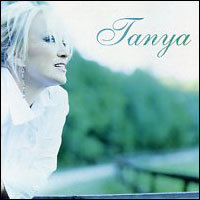
20. Tanya (2002) – Following 1997’s label dispute over the superior Complicated, Tucker took a five-year break from the studio and emerged with this offering on her own Tuckertime imprint. Produced by Barry Beckett and Jerry Laseter (Tucker’s fiancé at the time), the record is a fairly solid collection sturdily sung and nicely arranged. Laseter, with whom Tucker had her third child, Layla, in 1999, wrote several of the album’s songs, with Tucker herself pitching in on the penning of “Should’a Thought About That.” Despite the album’s strengths, it failed to make much of a mark, peaking at #39. The two released singles, “A Memory Like I’m Gonna Be” and “Old Weakness (Coming On Strong),” only made it to #34 and #49, respectively.
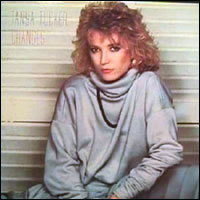
19. Changes (1982) – Following her late-70s foray into rock and her tabloid-fodder relationship with Campbell, Tucker poured herself into this record as a sort of return to her roots, even cowriting the title cut, which deals with reluctantly saying goodbye to a love that just isn’t working despite how badly you want it to. A solid effort throughout, the record nevertheless failed to make much of an impact and stalled at #47 on the charts. Released on Arista Records after her last few MCA records faltered, Changes proved her only album on the label, and a three-year break from recording followed.
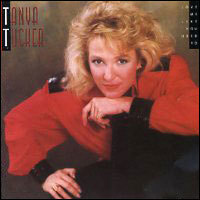
18. Love Me Like You Used To (1987) – Following on the heels of her 1986 comeback album, Girls Like Me, Love Me Like You Used To continued what would prove a successful formula for Tucker and producer Jerry Crutchfield, spawning three Top 10 hits, including two chart toppers: the aching title cut, the rollicking “If It Don’t Come Easy,” and a collaboration with Paul Overstreet and Paul Davis, “I Won’t Take Less Than Your Love.” It could be said of Tucker’s string of successful late 80s/early 90s albums with Crutchfield that they followed a rather predictable formula: 10-song sets of singles and filler with material pulled from the Nashville song mill. Tucker had all but fully moved away from the hard-living story songs and sexually charged selections of her 70s records, by this time fully embracing a more Top 40 country-pop sound. And who could blame her? It was proving to be a successful formula and was, quite simply, how Nashville worked at the time. Tucker rode the wave for years.

17. Strong Enough to Bend (1988) – Tucker’s mid-80s resurgence as one of Nashville’s leading ladies sailed right along with this record, which follows the same formula as the two albums released before it. Bolstered by the harmonious title cut, penned by songwriting pro Beth Nielsen Chapman and still a fan favorite today, the album also contains Tucker’s ode to her manager-father Beau with a cover of the Jimmie Rodgers tune “Daddy and Home” and the flirty “Highway Robbery,” which finds Tucker using her feminine wiles on a highway patrolman.
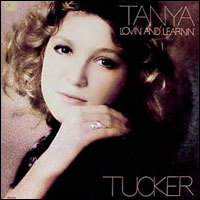
16. Lovin’ and Learnin’ (1976) – Tucker’s fifth album began a long and fruitful collaboration with producer Jerry Crutchfield, who would end up producing 14 of the albums in her discography (although not consecutively). The record kicks off with a classic Tucker story song, “Pride of Franklin County,” and eases smoothly into cuts like rocking covers of Fats Domino’s “Ain’t That a Shame” and the Eagles’ “After the Thrill is Gone.” Charting singles “Don’t Believe My Heart Can Stand Another You” and “You’ve Got Me To Hold On To” added two more hits to Tucker’s growing catalog of material.
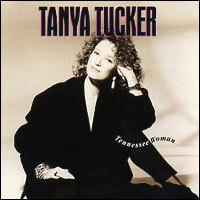
15. Tennessee Woman (1990) – The cover for this 1990 album shows a more sophisticated Tucker and has material to match. The polished effort racked up three more Top 10 hits, including the bouncy “Walking Shoes” and the incendiary duet with T. Graham Brown, “Don’t Go Out.” Beyond the singles, Tucker and Crutchfield’s annual recording routine of cutting the standard Nashville fare of the day continued. One standout, however, was Tucker’s songwriting collaboration with Gary Stewart on the title cut, a tune written for then-boyfriend Ben Reed, who fathered Tanya’s daughter Presley, born in 1989, and son Beau Grayson in 1991.
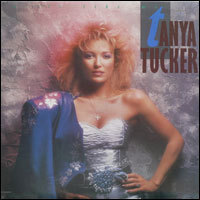
14. Girls Like Me (1986) – In 1986, it seemed as though Tucker’s career was over. The sexually charged image, drugs, wild romances, and tabloid fodder had seemingly alienated her from the conservative-leaning country music industry, a notion punctuated by the failure of this record’s predecessor, Changes. In fact, following that album’s poor performance, Tucker took a three-year absence from the studio to regroup – a decision that proved successful…and proved her naysayers wrong. Landing at Capitol Records for what would be a long, successful run, Girls Like Me became a true comeback album and catapulted Tucker back onto the country charts in a big way, with four Top 10 hits, including the #1 “Just Another Love.” The record balanced radio-friendly singles (“One Love at a Time”) with aching ballads (“It’s Only Over for You”), while songs like “I’ll Come Back as Another Woman” proved that nobody in country could do sultry like Tanya Tucker. The Matraca Berg-penned title cut, with the line “I guess love was never meant to be for girls like me,” finds Tucker acknowledging her past romances, while a fine cover of Kim Carnes’ “Still Hold On” closes out the set. Paired again with producer Crutchfield, who would go on to helm Tucker’s records well into her 90s heyday, the album’s production may feel a bit dated today but was right on par with the sounds coming out of Nashville in the mid- to late-80s.
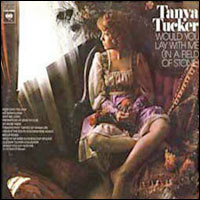
13. Would You Lay with Me (In a Field of Stone) (1974) – Tucker’s third album was anchored by the David Allan Coe-penned title cut, which shot to number one, and continued the trend of adult themes and hard-edged story songs that was clearly Tucker’s preference. The track – and the boldness of naming the album after it – positioned the rising star well beyond her then-15 years, as did other cuts like “Bed of Rose’s” and the single “The Man That Turned My Mama On.” A few months after the record dropped, Tucker appeared on the cover of Rolling Stone (one of few country artists to do so at the time) with the headline, “Hi, I’m Tanya Tucker. I’m 15. You’re gonna hear from me.” Indeed we did. It’s a solid effort with some soulful singles and a bit of album filler – a format that would all but define Tucker’s recording routines throughout most of her discography.
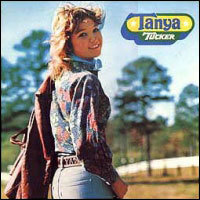
12. Tanya Tucker (1975) – After leaving Columbia for a famously million-dollar contract with MCA , Tucker stuck to a successful formula for her self-titled fourth album – more emotionally sung, evocative love songs (“Love of a Rolling Stone”), story songs (“Lizzie and the Rainman”), and well-chosen covers (“I’m Not Lisa,” “When Will I Be Loved” and “Son of a Preacherman,” all of which work well with Tucker’s maturing voice). Both “Rainman” and single “San Antonio Stroll” landed atop the charts, the former securing Tucker her then-highest-charting crossover success at #37 on the Billboard Hot 100 and #7 on the Adult Contemporary charts. The album itself rose to #8 on the country charts and was Tucker’s most consistent record of her early career.
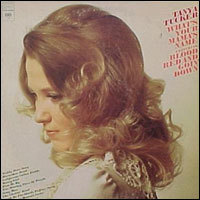
11. What’s Your Mama’s Name (1973) – If the previous year’s Delta Dawn debut suggested Tucker was a wise-beyond-her-years vocal interpreter, this follow-up cemented it. She continues to sound right at home with grittier material, like the title cut and “Blood Red and Going Down,” about a 10-year-old girl who witnesses her father killing her cheating mother. Both singles scored Tucker her first #1 hits. It’s on these more adult-themed cuts that Tucker really shines. In fact, you can practically hear her discontent with tunes like “The Teddy Bear Song,” as if she’s singing this softer material merely because someone told her she had to. But even on those songs, the 14-year-old delivers. Meanwhile, primarily a soulful interpreter of other people’s lyrics, this album allows Tucker to lend her lyrical prowess to “Rainy Girl.” Ultimately, this record helped Tucker avoid the sophomore slump and scored a couple more signature tunes to her growing list of hits.
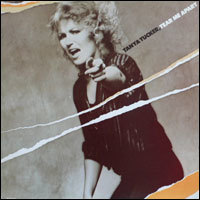
10. Tear Me Apart (1979) – Following the more rock-tinged TNT in 1978, Tear Me Apart steers Tucker even further from country music and deeper into rock and roll territory, only less successfully than its predecessor. Produced by British rocker Mike Chapman, the album failed to connect with audiences and, for the first time in Tucker’s career, failed to produce a charting single. Despite the commercial failure of the album, Tucker’s roughest record does indeed rock, and she has since referred to it as both “the cheapest record I ever cut” and one of her personal favorites. In recent years, Tucker reflects on her foray into rock as a valiant attempt to broaden the horizons of country music, admitting she did it with the wrong people. She has credited Garth Brooks with being the first artist to truly break down the genre barriers. Tear Me Apart, meanwhile, has developed a bit of a cult following and remains Tucker’s most adventurous collection of songs to date, hence its high placement here despite the commercial failure. In fact, a recent online fan poll placed this record all the way at the second spot in a similar album ranking. And, if I weren’t trying to inject at least some objectivity into this list, that’s probably where it would land for me as well.
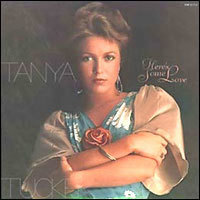
9. Here’s Some Love (1976) – Tucker begins to broaden her sound with her sixth album, a blend of soulful ballads (“Comin’ Home Alone”) and plugged-in, poppy, up-tempo numbers (“Gonna Love You Anyway”). The title cut sailed to the top of the charts, adding another staple to Tucker’s song catalog, while the funky “Short Cut” hints at an edgier sound that would only continue to expand throughout the latter half of the decade. Despite veering from traditional country, the album reached #1 on the charts – Tucker’s only album to do so to date.

8. Sweet Western Sound (2023) – Expectations were high following the career-reviving success of 2019’s comeback record While I’m Livin.’ When Carlile and Jennings returned to the studio with Tucker for its follow-up, they embraced the Americana vibe of that album while adding in a bit more of a traditional country flare and, here and there, cinematic production. The result is another stellar collection that was embraced by critics and fans and has continued Tucker’s current momentum. It did, however, make a smaller splash that its predecessor. Where While I’m Livin’ embraced all the parts of Tucker’s legendary persona, including her wild side, its follow-up is a largely subdued affair, filled with gut-wrenching ballads that has Tucker reflecting on her life as though she’s at the end of it. There aren’t any bangers in its brief track list. In fact, she barely gets above mid-tempo at all. However, it’s still an excellent album, showcasing not only Tucker’s life-worn voice to full effect but also her songwriting skills.
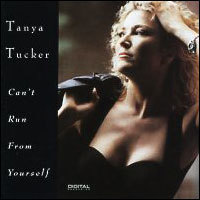
7. Can’t Run from Yourself (1992) – On the heels of a CMA Female Vocalist of the Year win and the hit-filled, Album of the Year-nominated What Do I Do With Me, Tucker released this solid follow-up, which contained another batch of hit singles and a Grammy-nominated duet with Delbert McClinton (“Tell Me About It”). From the honky-tonkin’ opener, “It’s a Little Too Late,” to the emotive ode to her parents’ 50-year marriage, “Two Sparrows in a Hurricane,” Can’t Run From Yourself continued Tucker’s hot streak. Her hard-livin’ growl lends itself well to the bluesy Marshall Chapman-penned title track and album cuts like “Don’t Let My Heart Be the Last To Know.” It’s a Tucker record, so there’s some filler between the standouts (there are a couple ballads peppers in there that don’t really go anywhere), but this overall solid blend of country and blues has held up quite well.
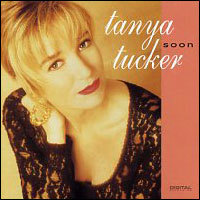
6. Soon (1993) – This critically acclaimed album is perhaps Tucker’s most sophisticated record to date. Throughout the 10 songs, she shifts nimbly from seductive (“You Just Watch Me”) to contemplative (“We Don’t Have to Do This”) to bouncy (“Come On Honey”) to heartbroken (“Soon”). While largely a collection of well-chosen ballads, even the funner numbers suggest a certain level of maturity missing from previous efforts. But it’s on the slow numbers that Tucker truly catches fire here, especially the title track, which landed at #2 on the charts. Always one to get to the emotional core of even the blandest lyric with her emotive voice, deep cut “Silence is King” is one of Tucker’s most aching recordings ever.
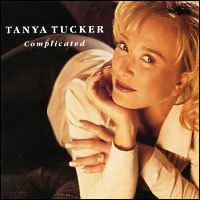
5. Complicated (1997) – Tucker’s self-described common routine in the studio was to hear a demo, cut the track, and move on. But after 1995’s disappointing Fire to Fire, Tucker took her time with this one, “living with every song,” and it shows. She parted ways with longtime producer Jerry Crutchfield and linked up with Gregg Brown for what remains one of the most consistently satisfying records of her entire career. Opener “Ridin’ Out the Heartache” suits Tucker’s throaty growl to a tee; she’s obviously having fun on rockers “What Your Love Does for Me” and “You Don’t Do It;” and the gorgeous “All I Have to Offer You is Love” is one of her best ballads. Unfortunately, a dispute with the label over the album’s marketing caused the record to stall after lead single “Little Things” hit the Top Ten. Released to coincide with her 1997 autobiography Nickel Dreams, this critically acclaimed but somewhat overlooked gem marked the end of Tucker’s 90s chart reign.
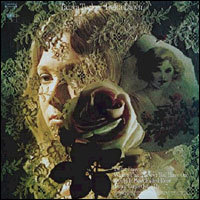
4. Delta Dawn (1972) – The second Tucker launches into the now-classic opening line of the title track on her debut album, you know you’re in for something special. Her unpolished, throaty warble proves a natural fit for the mature lyrical content of cuts like “If You Touch Me (You’ve Got to Love Me)” and “Loving You Could Never Be Better,” her emotive delivery masking that she is all of 13 years old here. As she dives into lyrics about heartbreak, love, and sex, it’s easy to forget that fact. In fact, listeners discovering Tucker today would likely never pinpoint her age if they didn’t already know it. As the legend goes, it was Tucker who insisted on releasing the mature “Delta Dawn,” despite push from the label for the seemingly more age-appropriate “The Happiest Girl in the Whole USA,” which does appear toward the end of the album. And while Tucker gives the lighter material her all, it’s on the rougher, more mature lyrical content that she truly shines – then and now. It’s the record that introduced us to a future legend and gives us her signature song.
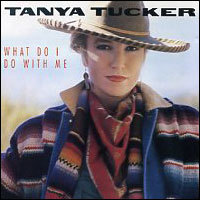
3. What Do I Do With Me (1991) – After years of CMA Female Vocalist of the Year nominations, this record finally brought the trophy home for Tucker, scoring an Album of the Year nomination as well and landing at #6 on the country album charts, as well as #48 on the Billboard 200. Continuing the Tucker/Crutchfield annual recording routine, there isn’t necessarily anything groundbreaking about the album’s material – simply a consistent early-90s Nashville effort, cleanly produced, solidly sung, and chock full of radio-ready tracks. Four singles sailed into the Top 10, adding more career staples Tucker fans still cling to today, like the fun “Down to My Last Teardrop,” the sultry “Some Kind of Trouble,” and the toe-tapping “If Your Heart Ain’t Busy Tonight.” There’s also an aching ode to the American farmer (“Bidding America Goodbye”) and deep-cut “Right About Now” has apparently become a favorite of Tucker’s daughter Presley. In fact, even the deep cuts rise above the Nashville filler fare of the day, resulting in a consistently strong record from start to finish.
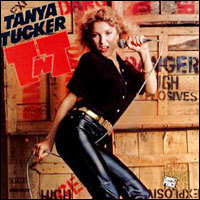
2. TNT (1978) – TNT proved quite a departure for Tucker, as she began to rebel against the conservative nature of country music and attempted to introduce a more rock-based sound. Even the album’s artwork indicates that this isn’t going to be your grandma’s country music. The cover shows Tucker seductively straddling a microphone cord, while the inner artwork depicts her in a skin-tight red jumpsuit clutching a stick of dynamite and licking her lips. And while the country music establishment reacted expectedly, the album nevertheless proved a critically and commercially successful effort, earning Tucker a Grammy nomination for Best Rock Vocal Performance. A solid collection of originals and well-chosen covers, Tucker puts her stamp on Buddy Holly’s “Not Fade Away,” Elvis Presley’s “Heartbreak Hotel,” and John Prine’s “Angel from Montgomery,” her trademark rough vocals set against driving rock arrangements. Ironically, despite the rock-leaning production, the album scored Tucker one of her most country-tinged signature hits: “Texas (When I Die).” Tucker herself has been hard on this record, not really counting it among her favorites. But from packaging to production to song selection, it is nonetheless a fan favorite and a true classic in her long discography.
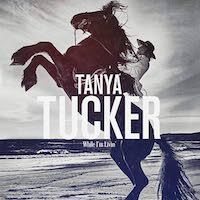
1. While I’m Livin’ (2019) – When Brandi Carlile, herself riding a career-high wave, heard that Shooter Jennings was cutting a record with Tucker, the singer-songwriter inserted herself into the mix with the love and respect of a true fan. Carlile and her writing partners, Tim and Phil Hanseroth, began a deep-dive into Tucker’s life and career and crafted a batch of songs that are more “Tanya Tucker” than anything she has ever released. The biographical tunes are like a scrapbook of Tucker’s historic career, coupled with well-chosen covers that result in a perfect album, at turns rowdy and aching. Tucker’s weathered voice wraps itself around these songs, and Jennings’ and Carlile’s sparse production settles Tucker perfectly into Americana territory. There’s no glossy Nashville production here. Tucker’s voice is raw and real, and the music lets her shine. Not since Johnny Cash teamed with Rick Rubin or Loretta Lynn with Jack White have results been as sweet as this – a reinvention of sorts for a living legend late in her career. The record catapulted Tucker back into the limelight, leading to multiple Grammy nominations, including Song of the Year (all genres) for the Tucker co-penned “Bring My Flowers Now.” She took home two trophies that were long overdue, and is still being brought her flowers by fans and the music industry since its release.
So there you have it. Nearly five decades into a career that’s as strong as ever, Tucker released the best record of an already extraordinary discography.
October 25, 2020
Why Keep a Book After You’ve Read It?
“A man’s bookcase will tell you everything you’ll ever need to know about him.” – Walter Mosley
Last year, I was having a conversation with friends in a bookstore/café, back when we were actually able to gather in bookstore/cafés and have conversations with friends, when one of them asked the question, “Why keep a book after you’ve read it?”

The conversation drifted to other topics without any real discussion, but it’s an interesting question, one I’ve returned to since while sitting in my personal library and surveying my own books. As a way to simplify a response, I’ve managed to categorize my inventory into the following.
Books I love. We all have our favorites – books we read and return to over the years. I can’t imagine a library without a copy of Leaves of Grass or To Kill a Mockingbird or The Grapes of Wrath. These are books I want to own, despite having read them multiple times over.Books I collect. I always keep my eyes peeled for old books from the Wizard of Oz series, whether by Baum or one of the other authors considered canon. I’ve amassed a rather small but lovely collection. I’m also a sucker for Sherlock Holmes volumes and have a first-edition set of the Harry Potter books. (The author herself has done irreversible damage to her credibility, in my opinion, but one hopes that, in the case of the Harry Potter world, the art can be appreciated separately from the artist – a notion that is an entirely other post in which to dig). Book collecting is a world unto itself, and while I hardly consider myself a true collector, I do have titles always on my watch list when I visit a used bookshop. Books I haven’t read yet. To be honest, this category makes up a large chunk of my library. I never want to be without something new to read, and I keep my shelves stocked with books that have intrigued me, have been recommended to me, or are literary classics that I want to experience eventually.Books I will pass along. I actually don’t always keep a book after I’ve read it. Sometimes I’ll read and love a book, but I know it isn’t one ever I want to revisit. Sometimes I just won’t like a book and perhaps don’t even finish it. Sometimes I can’t wait to give a book to a friend who I know will love it as much as me. I never throw books away, but I do periodically gather up ones I’ve read and pass them along to other readers or donate them to used bookshops so that someone else can discover and enjoy them. Plus, the latter is a good way to rack up credits at the shop so you can replace those donated books with more.

I’ve shared here the reasons why my shelves are filled with the books I own. But to take it deeper, I don’t ever want to consider a book, or any other work of art, as disposable. Why keep a book after you’ve read it?
Well, why hang a painting on your wall after you’ve looked at it? Why listen to a song after you’ve heard it once? Why watch a movie after it’s already been seen? Because works of art aren’t meant to be disposable. They’re meant to be valued, appreciated, and (hopefully) enjoyed time and again. That’s certainly something we hope for when we’re creating them.
I’d love to hear your response to the question at hand. Why do you keep books you’ve already read? Share what’s in your personal library in the comments.
October 3, 2020
6 Empty Nest Episodes Every Golden Girls Fan Should See
I was recently corresponding with one of the hosts of the Enough Wicker podcast, who admitted to having never seen an episode of The Golden Girls spinoff series, Empty Nest. I can’t say I was terribly surprised. The reasons for this could be plentiful.
A lot of Golden Girls fans have discovered – and fallen in love with – the show in more recent years through reruns, DVDs, and streaming, not during the original run, when the two shows were paired together on Saturday nights.Empty Nest hasn’t had the pop culture impact of its sister show. It’s aired in repeats a few times since ending in 1995, most recently for a few years on Laff, but that hasn’t been enough to see it embraced by generations of new fans. It also isn’t available on DVD and doesn’t stream anywhere. Episodes can be found on YouTube, but that’s not the same as a Hulu binge. Let’s be honest: Empty Nest was a far less observant show than The Golden Girls. It tackled issues from time to time (artificial insemination, teens carrying guns, single parenthood, gay rights, the empty nest syndrome – duh), but the writing wasn’t necessarily as groundbreaking or impactful as The Golden Girls, perhaps adding to the supposed ease of overlooking it.No one in the cast has had the remarkable longevity as someone like Betty White. Richard Mulligan died in 2000; Kristy McNichol hasn’t acted since leaving Empty Nest during its fifth season; and Dinah Manoff, David Leisure, and Park Overall have all retired.
So for many Golden Girls fans, their only exposure to Empty Nest is when the characters appear at the girls’ front door, which is a shame. In its prime, Empty Nest was actually one of the most-watched series on television. Richard Mulligan won an Emmy for playing Dr. Harry Weston, and Park Overall was nominated for multiple awards as Laverne. The show itself was once up for Best Comedy Series at the Golden Globes, and beginning with its third season (The Golden Girls’ sixth season), Empty Nest became and remained the highest-rated show on Saturday nights, which helped lead to its own spinoff series, Nurses. Garth Brooks even chose the show to make his acting debut in 1991.
Getting back to my original point, I began to wonder what episodes I would recommend to a Golden Girls fan looking to sample Empty Nest. The easiest introduction would be to pick out some of the crossover episodes, especially the ones that tie directly back to an episode of The Golden Girls and may, at long last, answer some nagging questions for fans.
So, here are 6 Empty Nest episodes every Golden Girls fan should watch.
1. Fatal Attraction: Season 1. Written by Susan Harris. Directed by Hal Cooper. Original airdate: November 5, 1988
At the end of The Golden Girls episode “Yokel Hero,” Harry and Dreyfuss stop by to drop off the girls’ mail and, after he leaves, the girls discuss the fact that an appropriate amount of time has passed since his wife died and, therefore, he’s back on the market. Blanche is especially eager to reintroduce him to the dating scene. This episode aired immediately after that one in 1988, and sees Blanche relentlessly throwing herself at Harry. It’s a very early Empty Nest episode. Carol and Barbara are yet to move back into the house, which they didn’t do until midway into the first season.
2. Dumped: Season 1. Written by Susan Beavers. Directed by Hal Cooper. Original airdate: February 18, 1989
Both Rue McClanahan and Bea Arthur made one crossover appearance on Empty Nest, and this is Bea’s. The episode sees Barbara falling for Dorothy’s nephew (presumably Gloria’s son, but it doesn’t factor into the plot). When the relationship sours, so does the friendship between Harry and Dorothy. I like the interactions between Bea and Richard. That may’ve actually been fun to explore more, but it never happened. And there’s a great exchange between Dorothy and Laverne, two tough-as-nails characters.
3. Rambo of Neiman Marcus: Season 2. Written by Arnie Kogen. Directed by Steve Zuckerman. Original airdate: September 23, 1989
While Betty White’s other crossovers were cameos, this episode has her central to the plot when Harry gets into a car accident with Rose. It’s the episode’s B-plot, but she still gets plenty of screen time and arguably the episode’s biggest laughs, especially – again – in her interactions with Laverne at the hospital. (If you don’t know, Laverne was a breakout character on the show. They even toyed with a spinoff for Park Overall at one point.) The main plot deals with Carol, who becomes a media darling after stopping a robbery while her cop sister, Barbara, stands by.
4. Windy: Season 4. Written by Arnie Kogen. Directed by Steve Zuckerman. Original airdate: November 9, 1991
Ah, NBC’s infamous Hurricane Saturday event, when a storm pounds Miami and characters from The Golden Girls, Empty Nest, and Nurses (which has now entered the picture) pop up on one another’s shows with the interwoven thread of the storm. Carol was on Girls, Sophia was on Nest, and Rose and Laverne were on Nurses. This year was peak Empty Nest, and this particular episode drew massive ratings (perhaps helped even more by the previous week’s Garth Brooks episode). Of the three shows, this episode has the most consistent laughs, not to mention special effects, as the storm is in full force here. The plot sees Harry deciding to sell the house when his dream home comes on the market, and Laverne braces for a visit from her overbearing mother-in-law (played by Ann Guilbert of The Nanny).
5. Dr. Weston and Mr. Hyde: Season 4. Written by Peter Gallay. Directed by Doug Smart. Original airdate: February 29, 1992
A few months after the success of Hurricane Saturday, along came Full Moon Saturday, another round of interwoven crossover appearances, this time with the thread of full moon madness. And once again, Empty Nest delivers with the biggest laughs of the night. The plot sees Harry behaving very strangely after taking some new medication, but Laverne is quick to attribute his erratic actions to full moon fever. Richard Mullligan was known for his zany brand of physical comedy during his years on Soap, another Susan Harris creation, but Harry was much more of a straight-laced character, so this episode lets the actor play, and it’s fun to see. Meanwhile, the B-plot is a bit of a gimmick. Barbara hires a mysterious handyman who bears an uncanny resemblance to…Dreyfuss. And when she’s unable to catch the two of them together, she begins to wonder if they are one and the same.
6. The Ballad of Shady Pines: Season 6. Written by Rick Newberger. Directed by Steve Zuckerman. Original airdate: February 12, 1994
This late-era episode may be a little unsettling for Golden Girls fans. After Kristy McNichol left the show in season five, Empty Nest struggled to find its balance (and arguably never did). For its sixth season, Harry and Laverne were moved from the hospital to a struggling inner-city clinic led by Dr. Maxine Douglas (played by Night Court’s Marsha Warfield). And, to fill the McNichol void, Estelle Getty was brought on as a regular since The Golden Palace had failed to get a second season order. The explanation for Sophia’s return to the neighborhood was that she’d moved back into Shady Pines. This episode actually shows us what the long-referenced nursing home looks like – and it’s the same set used as the home of Max Weinstock from The Golden Girls! The plot has Laverne working at Shady Pines, and she becomes unwittingly embroiled in a love triangle with Sophia and Sophia’s lecherous boyfriend. Brace yourself: the boyfriend is played by none other than Bill Dana – Angelo from The Golden Girls! So that’s…weird. But that’s not all. Other Shady Pines residents will look familiar, too. Keep your eyes peeled for Sid Melton (Sal Petrillo) and Phil Leeds (Guido Spirelli). There’s also a B-plot involving a housesitting battle between Charley and Maxine, but let’s face it: Girls fans are here for the Shady Pines action.
October 2, 2020
What Qualifies You to Write a Golden Girls Book Anyway?
My life has been immersed with The Golden Girls this year. While this differs little from my life any other year, it’s taken on considerably more heft since January. If you know me, follow my social media presence, or have looked around this website, you probably already know the following:
I recently signed a contract with Globe Pequot, a division of Rowman and Littlefield, to publish what I tentatively titled Isn’t Danny Thomas One? The Definitive Golden Girls Reference Guide. The title could very well change as I navigate the editorial process. The target audience will get it. But is it too specific for the casual fan? We’ll figure that out later.
Anyway, I’d been percolating this idea for quite a long time. If you’ve seen even one episode of The Golden Girls, you’ve undoubtedly heard a joke referencing a person, company, event, product, etc., that gets big laughs from the studio audience but, if you’re younger than, say, 35, you very likely haven’t the foggiest idea what they’re talking about. Wouldn’t it be nice, I said to myself, if there existed a book that explained all of these references? Like a Golden Girls pop culture encyclopedia! So I pitched it to my agent in January. He believed in the idea and urged me to write a book proposal. (That’s generally how it’s done. If you’re writing a novel, you write the novel and sell it. If it’s non-fiction, you write and sell the proposal, then write the book itself.)
Now, if you’ve never written a book proposal before, one of the common components in the pitch is to convince a potential publisher that you are in fact the person to write this book. If I were writing a book about marine biology, I would discuss my credentials as a marine biologist. So what qualifies me to write a book about The Golden Girls? I’m not a Golden Girl. I wasn’t involved with the show. I’m not Bea Arthur’s grandson. I was all of 12 years old when the show ended in 1992.
But we sold the book in a matter of weeks, so the concept, coupled with my supposed qualifications, must’ve been enough. While I didn’t go into all this detail in the proposal, I did seriously ponder what I felt qualified me to be the person to write the book, so I thought I’d elaborate here.
Without further ado, here’s why I feel more than qualified to consider myself a Golden Girls expert.
I’m of the age, like a lot of us, who grew up watching NBC’s Saturday night lineup with my grandma. Every weekend, waiting for The Golden Girls and Empty Nest was very much a thing for me.I vividly remember watching various episodes during the original run, to this day: the Shelley Long joke from The Housekeeper, Blanche making her way to Sicily to track down a runaway Sophia, the hurricane crossover night. I watch the episodes now and still recall the original airing.I religiously watched the reruns when they landed on Lifetime in the 90s and recorded them on VHS, before owning seasons of TV shows on DVD was a thing.When I got my first computer with high school graduation money, instead of looking up what one might think a teenage boy would look up on the internet, I was searching for The Golden Girls and Empty Nest.I involved myself in the online Golden Girls fandom, which was already active even in those early days of the internet. We’re talking mid- to late-90s. The era of chat rooms, message boards, email lists, ICQ, and Geocities fan sites.Realizing that, even then, Golden Girls fandom was massive but Empty Nest was getting a little left behind, I decided to pick up the torch for it myself and created my own Empty Nest fan site at Geocities. I taught myself HTML code, because WordPress templates were 15 years in the future. (Stay with me on this Empty Nest connection. I know The Golden Girls is superior, but for me these shows are a match set.)When The Golden Girls began being released on DVD, I purchased each season as soon as it came out and watched and rewatched. I’ve relished in the revival of the show’s (and Betty White’s) popularity with the masses. There’s always been the online love, but nothing like what has happened the past several years. I admittedly don’t own a lot of the merchandise, but I do have some select pieces – the Funko Pops, some of the board games, a couple coffee mugs, the cereal. (Yes, the cereal. I even bought two boxes: one to keep and one to try. It sucked.)When it landed on Hulu, I began streaming it routinely. I’m on my second rewatch for the book alone.All the while, I’ve kept the Empty Nest site alive, eventually moving it to WordPress and setting up pretty active social media accounts on Facebook and Twitter.In 2015, I launched an Empty Nest reunion interview series, hoping I might be able to reach a crew member or two. Instead, in the span of a week or so, I was trading emails and phone calls with Dinah Manoff, Park Overall, David Leisure, Marsha Warfield, and others.Those interviews revealed some very interesting insights about the Girls and what they were like around the set – Bea Arthur’s strong dislike of both chewing gum and Betty White were recurring morsels. I’m now forty and have spent the bulk of my life being what I guess one might label a “super fan” of The Golden Girls and Empty Nest. And I’m proud of it! And as for credentials, I also have a master’s degree in marketing and have worked in the communications and media industry my entire career, so that helped with the pitch, too.
 Empty Nest: David Leisure, Park Overall, Richard Mulligan, Kristy McNichol, Dinah Manoff.
Empty Nest: David Leisure, Park Overall, Richard Mulligan, Kristy McNichol, Dinah Manoff.So while I never imagined I’d parlay my Golden Girls love into a book, I’m sure the other writers who authored Golden Girls books, or the hosts of Golden Girls podcasts or what have you, ever thought they’d do those things either – until they did them. Hell, when I taught myself HTML code at 17 to make an Empty Nest website, I never imagined I’d someday be on the phone with Park Overall hearing about Bea Arthur’s love of dirty books.
I’d never be so presumptuous as to proclaim myself the world’s biggest Golden Girls fan or expert or whatever you want to call it, because I’m sure there are plenty of folks who can make such a claim, but I’m pretty confident I can do this book justice. And I’m working hard to be thorough.
Now, I’ll happily express humility with the Girls, but if any of you even think of proclaiming yourself the biggest Empty Nest fan out there, I will fight you. I mean, I’m pretty much an honorary Weston after all.
 Dinah Manoff, David Leisure, Kristy McNichol and me.
Dinah Manoff, David Leisure, Kristy McNichol and me.July 8, 2020
My Book Came Out During a Pandemic
A quick update on my writing career, Sophia Petrillo style.
Picture it: Charleston, West Virginia, December 2019. After years of trying, an aspiring author releases his first book. It’s a book about West Virginia’s independent bookstores, with profiles of all the state’s shops and contributions from wonderful authors and booksellers. He launches it Fayetteville, WV, where he’s wrapping up a monthlong writer’s residency, and the response is strong. So are sales. The momentum carries forward into the early months of 2020, when he brings the book to towns all over the state.
The energy surrounding the project is great. The media picks up on it. He does a batch of TV and print interviews. He’s asked to host signings at several more places in West Virginia and even into neighboring states. His 2020 calendar quickly fills up into the spring, summer and even into the fall, where he’s accepted to be a vendor at the prestigious West Virginia Book Festival, an event that has drawn the likes of Neil Gaiman, James Patterson, Charlaine Harris, Erik Larsen, Debbie Macomber, R.L. Stine, and Henry “Fonzie” Winkler.
That’s a big one for him. Being part of that event has been a personal goal of his for years. He’s even more excited when someone suggests he apply to present his bookstore project as a session during the festival. He submits the application and waits.
But he doesn’t have time to stew over a response, because he’s suddenly very busy. His writer pal Brent Hartinger once told him, when he was lamenting the fact that his career wasn’t going anywhere, that good things would eventually start to happen…and happen quickly. It is a prediction that suddenly proves true. His second book – a children’s picture book – is almost off to the presses for a May release. And he’s still working on the project he began during the December residency. And he’s just had a new idea for a pop culture book that his literary agent believes in, so he’s got a proposal to write.
Boy, 2020 is looking to be a good year for this new author! Then a global pandemic strikes.
Businesses shutter. Sales of the bookstore book ground to a halt. Publication of the children’s book gets bumped to some far-off point in the distance. And that calendar of in-person events – including the West Virginia Book Festival – is wiped clean. He’s so disappointed.
But he doesn’t feel sorry for himself or mope over lost opportunities, because he knows in the grand scheme of things, those canceled events and appearances will eventually return. His lost revenue in book sales is nothing compared to the lost revenue of the shops his book so lovingly lifts up, which are forced to close their doors for weeks and then months. Like the rest of the world, he hunkers down, listens, learns, and tries to stay healthy.
By summer, many of those shops begin to cautiously reopen with safety measures in place, because the pandemic is still raging. His children’s book project is back on track for a late-summer release. And that pop culture book proposal? He’s not allowed to discuss it yet, but very good things are happening on that front. So while in-person events won’t be revived for a long time, he’s still very grateful to finally have his career moving forward and is adjusting to being a writer during a global pandemic, just like every other writer out there.
That aspiring author was me. And that pandemic was the COVID-19 coronavirus.
December 31, 2019
How to Throw a Book Launch Party
In December, I had the pleasure of hosting my first-ever book launch party. After years of aspiring to be a published author, I’ll admit to plenty of daydreaming about what a book launch party would look like. I envisioned my friends gathered around my local independent bookshop, sipping wine and eating finger foods, while I regaled them with stories about the process of writing my novel.
Things didn’t quite happen in that manner exactly, but I did have a very successful (perhaps more than I’d hoped) party. First of all, my “novel” ended up being a regional travel guide of sorts about my home state’s independent bookstores. Secondly, the book released when I was smack in the middle of a creative residency program a decent distance from my home city (and that aforementioned local indie bookstore). So I had, I presumed, two options: postpone a launch until a month later, when I was back to reality, or forego a book launch party altogether.
Fortunately, the decision was made for me thanks to a chance meeting and my love of a good cocktail. My second night at the residency, I ventured out to the local pub, where I struck up a conversation with some folks about the book, one of whom began texting as I talked. Moments later, a local music and arts event venue had agreed to host a launch party for me! (Mind you, the town – Fayetteville, West Virginia – is very arts-focused and supportive of the creative residency program I was there for, so that was certainly a factor.)
Now, I’ve read several “How to Throw a Book Launch Party” blogs over the years, and they tend to offer variations on the same advice. I’ve plucked a few tidbits that I found most pertinent and will share how they helped me host a successful event.

1. Choose the right venue.
Obvious, no? As I said, my local indie was my venue of choice, but I wasn’t local at the time! Luckily, the venue was chosen for me. It wasn’t a bookstore, but a cool, popular event space that hosts live music, art shows, and other activities. So there was a built-in stage area, A/V equipment, plenty of local cred, and a track record of well-attended and well-hosted events, including book-related ones. So, if you don’t have a local indie bookshop, venture outside what might be considered the norm and see what else your town has to offer – an event space, a bar, a coffee shop, your friend’s cool literary-themed lounge…whatever works.
2. Harness the power of media.
Traditional and social, that is. Spreading the word is, again, obvious. Set up a Facebook event page and share the hell out of it. Look for writing-related social media pages/groups in your area and let them know. Ask your friends to share it. My venue luckily had a very active social media presence, and the town itself had a popular event-sharing Facebook page. Look for such things in your area. Also, don’t limit yourself to social media! I happen to work in marketing and communications in my day job, so I already have media contacts and the know-how to reach out to them. If you don’t, just google news release templates and write one up, then scour the websites of all your regional media outlets – TV, print, radio – and gather their email addresses. Send it out a couple weeks ahead of the event. Look online for community calendar websites and add it there, as well. You can always do follow-up calls as the event nears if you’d like. And print up some flyers and posters to hang around town. (Printing and, depending upon how professional you want them to look, design are costs to consider but necessary ones, in my opinion.)

3. Provide refreshments.
Luck was in my favor here again. The venue was attached to a very popular local restaurant, so attendees had the option of ordering food from their menu, and the place served beer and wine. I did pick up some fruits and vegetables so people would have some snacks, but unbeknownst to me the venue and the lady whom I’d met at the bar had conspired to provide an impressive array of appetizers for the event. I wouldn’t suggest relying on such hospitality, so set aside some funds to pick up snacks. And that $3 wine from Aldi will certainly do if you’re buying in bulk on a budget!
4. Bring plenty of books.
I had boxes of the book in the back of my car, so this wasn’t an issue, but apparently some authors show up to events expecting no one and end up with a sizable crowd. I brought one box into the event, set some up for display, and kept the rest hidden until needed.

5. Decide on a structure and prepare to speak.
This was major for me. I’ve been to events where the author doesn’t say much at all and others where the author stands at a podium and gives a speech. Both are nice, but I wanted something a little more engaging and interactive. My favorite events are the “talk show” format style, where the author and an interviewer have a semi-structured conversation, followed by Q&A with the audience. So I reached out to a reporter friend to see if anyone at his station would be interested in doing the event with me. (It doesn’t have to be a member of the media, but I knew a reporter would be versed in conducting a good interview. Other writers, someone from the venue, even a chatty friend would work well here.) Luckily, one of the news anchors loved the book concept and volunteered. I prepared some suggested questions and got them to her, along with a gifted copy of the book, a few days in advance. We ended up having a fun, lively, and hopefully entertaining conversation. About 20 minutes was a good length. The venue’s A/V equipment and social media savviness (they Facebook Lived the event on their page) came in handy here.
6. Mingle.
The event was scheduled from 6 to 8 p.m. I knew I had friends driving in from home (an hour away), and I was told to operate on what locals call “Fayetteville time,” meaning people show up a half hour later than an event’s stated start time. So I made time on the front end of the structured portion to meet everyone and chat. This is a great way to meet the people who’ve come out to support your work and to relax yourself if there is a public speaking component that you’re dreading. (Writers are notorious introverts, after all.)
7. Say “thank you” a hundred times. And then some.
I was humbled by the support and effort extended to my event by the people of Fayetteville and everyone who had a hand in it. I still don’t feel like I’ve thanked them enough. (In fact, let’s do it one more time: Allison Taylor, Lewis Rinehart, Amy McLaughlin, Shawn Means, Kassie Simmons, everyone at The Grove, all the people of Fayetteville, and all my friends – old and new – who came out to show support: THANK YOU!) So yeah, profusive thanks is repetitive but these people went above and beyond. I’m sure you’ll have such supporters, too.
All in all, my book launch party could not have gone better. We had around 25 people attend, I sold 30+ books, and met so many amazing people. A lot of happenstance, luck, and neighborly goodwill went into my event, and I’m not sure I’ll ever be able to repeat it! But hopefully these tips will provide you with a case study and some usable blueprints for your own book launch party.
Writers: What are some of your book launch success stories (or challenges)? Share in the comments.
November 12, 2019
I Turned My Basement Into a Book-Themed Bar
“This is what I want,” I said as I sipped a delicious Great Gatsby (champagne, orange bitters, orange peel, sugar cube) inside Battery Park Book Exchange, a champagne bar/bookstore in Asheville, North Carolina.
In February 2019, I moved into a house that had a rather nondescript basement brimming with possibility: a wood-burning fireplace flanked by tall built-in bookshelves, a buffet space with cabinetry above and below, and plenty of empty space with which I had no idea what to do. A few months into living in the house, the basement had become a hodgepodge mix of boxes, unused exercise equipment, and unwanted furniture. Basically, a place in which I had no desire to hang out, let alone entertain.
 Before
BeforeBut the ambiance and décor at Battery Park Book Exchange set the wheels in motion. I could turn my basement into a literary-themed bar with rich colors, dim lighting, and a classic cocktail lounge vibe – all centered on a book theme, I thought. Forty-eight hours after returning from Asheville, walls had been painted, rugs had been purchased, furniture had been moved, and the Library Lounge and Reading Room was alive with spirit(s).

For the wall color, I chose a subtle gray, which I wanted to complement with deep reds in the rugs and curtains. A Victorian style area rug was top of mind for the floor. I also did a wallpaper backsplash on the bookshelves and cabinets to add a bit of flare. I was able to utilize many of my own furniture pieces – end tables, coffee table, a couple chairs, a chest converted into seating, the card catalog and library cart. A lot of the artwork I already owned as well, plus the typewriters, books, and other odds and ends.

I turned, for the first time, to Facebook Marketplace to round out some missing pieces. There I found a gorgeous leather wingback chair, made by what was a popular, high-end furniture maker here in Charleston, West Virginia, throughout most of the 20th century. There, too, I found a gorgeous Sherlock Holmes chess set to use as a centerpiece and that vital piece of bar motif: the bar itself!

Antiquing in my city’s many shops helped fill some gaps, including a couple more chairs, a gorgeous piece of Sherlock Holmes wall art, and several vintage whiskey ads. And the pièce de résistance – an item I’d been searching high and low for – was an antique book press. Scouring my regional stores turned up nothing but a few “good lucks” from skeptical shopkeepers; online hunts revealed either “local pickup only” or astronomical prices and shipping fees (a book press weighs a good 60 pounds); and every time a bookstore had one, it was for display only. After months of searching, I finally found one in good shape, reasonably priced, and in drivable distance at Lutz’s Antiques in Carlisle, Pennsylvania. (They actually had two in stock when I called.)

And with that gorgeous addition, my Library Bar and Reading Room is complete. Well, except for those hardwood floors and copper tin ceiling tiles I’d someday love to add! But that’s for another day.
November 9, 2019
A Look Ahead: Gearing Up for a Busy 2020
It’s been a bit quiet on the website lately, but I’m happy to say it hasn’t been because of inactivity. Several past periods of quietness could have been attributed to that, but not this time! In fact, I’m heading into the most active time I’ve had since launching this writing career so many years ago. I thought I’d provide a few updates.
New River Gorge Creative Residency
I have been selected as one of three creatives for the New River Gorge Creative Residency at Lafayette Flats in Fayetteville, West Virginia. I’ll be spending the month of December living in a flat in town and working on a brand new novel. It’s an idea that’s been percolating for a few years now and deals with Appalachian customs, culture, and lore in a modern-day setting. Fayetteville will provide the perfect backdrop for bringing this project to life, and I am extremely excited to get started! I’ll be journaling my entire experience and turning some of it into blogs, both here and for the Lafayette Flats website. Stay tuned!
Bookstore Explorer: West Virginia
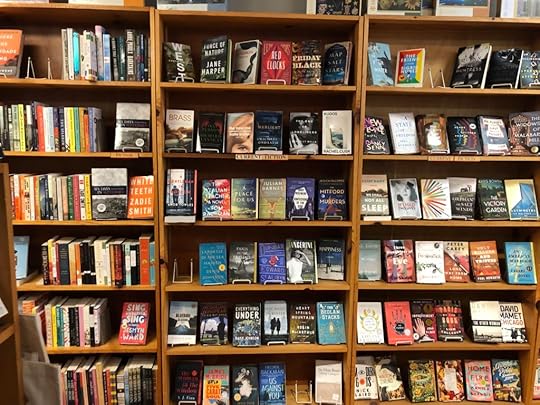
For years, I’ve visited indie bookshops during my travels and chronicled them on Instagram and a website. Last year, I decided to turn the idea into a full-blown book, beginning with my home state of West Virginia. So during the final months of 2018 and much of 2019, I combed the state in search of book-buying venues, from the standard indie shop to the nooks and crannies where you might not think to look. I also solicited essays from some of West Virginia’s greatest writers, plus booksellers, readers, and others plugged into the state’s literary scene. In their candid contributions they express why they, too, share my love of indies. After some obstacles along the road to publication, I’m excited to announce that the book will be released early in 2020! I’ve done the first round of revisions and will be doing a cover reveal soon.
Chicks and the City
A project from my day job sparked the idea for this children’s picture book about urban farming. I’m working with the wonderfully talented Ashley Belote to bring this project to life – and I cannot wait to see the sketches! (*checks inbox again*) We’re looking at a spring 2020 release on that one, from Headline Books.
So, as you can see, it’s a busy time as 2019 draws to a close. I’ll be sharing more details on each of these projects moving forward. Stick around!
June 15, 2019
Tanya Tucker Albums Ranked
Country music legend Tanya Tucker is set to release While I’m Livin‘ – her first album of original material in 17 years – on August 23. With a career spanning nearly five decades, Tucker burst onto the country music scene in 1972 as a 13-year-old with a husky voice and a penchant for hard-living story songs and sexually suggestive material. She has released more than 30 studio, live, and compilation albums; notched 10 #1 hits and 39 Top Ten singles; scored 10 Grammy nominations and countless CMA and ACM awards and nominations; written two books; released an exercise video; performed during the Super Bowl half-time show; launched lines of salsa, clothing, dolls, and (presently) tequila; and starred in her own reality TV show.
Long one of country music’s most skillful vocal interpreters and enigmatic figures, Tucker is as well known for her music as she is for her controversial personal life. One of the first artists in country music – if not the first – to succeed with an unapologetically sexualized image, Tucker has been called everything from the Madonna of country music to the female Elvis. The Texas Tornado’s career has certainly seen its share of highs and lows over the years: a greatest hits package and a Rolling Stone cover by age 15; a cocaine-fueled romance with a twice-her-age and married Glen Campbell at 22; a descent into the Los Angeles party scene and an ill-fated foray into rock and roll; an extended stint in rehab and a country comeback in her late 20s that led to chart topping singles, more Grammy nominations, and a CMA Female Vocalist award; a surprise pregnancy that inspired a “Honk if you’re the father of Tanya Tucker’s baby” radio campaign; and health issues that left her voice permanently altered. Through it all, Tucker has persevered. “Just call me Tanya Timex,” she once said. “I take a lickin’ and keep on tickin’.”

Now, thanks to superstar producers Brandi Carlile and Shooter Jennings, Tucker is finally being embraced and celebrated as the “outlaw country” music legend she is. Her new single “The Wheels of Laredo” is making waves on the Americana music scene and a show-stopping performance of her signature tune “Delta Dawn,” accompanied by Carlile and a host of country’s leading ladies, was called the performance of the night at the 2019 CMT Music Awards.
As the world awaits the release of While I’m Livin’ later this summer, let’s take a look at Tanya Tucker’s sizable discography, ranking her studio albums (numerous compilations and live albums omitted) from worst to best.

25. Fire to Fire (1995) – After a long, successful run with producer Jerry Crutchfield – a run which included Tucker’s mid-80s resurgence and 90s reign as one of country’s contemporary leading ladies – this 1995 offering barely manages to catch fire and marked the end of the Tucker-Crutchfield recording relationship. Lead single “Between the Two of Them” is another homage to the longevity of love, a la 1992’s beloved “Two Sparrows in a Hurricane,” only much less interesting. The tune stalled at #27 on the charts. Follow-up single “Find Out What’s Happenin’” – originally recorded by Bobby Bare – fared even less well, barely cracking the Top 40, while the title cut, a duet with Willie Nelson, squanders the talent of the two legends. The record isn’t without its moments, though. “I Bet She Knows” is classic midtempo, sultry Tucker; “I’ll Take Today” is a sweet ode to love; and the Delbert McClinton-penned “The Love You Gave to Me” is a solid slice of gospel-tinged country. Beyond that, this one is certainly one of Tucker’s weakest efforts.

24. You Are So Beautiful (1977) – Technically a compilation album, this collection was released by Columbia Records in 1977, well after Tucker had moved on to MCA, and pulls together unreleased songs she cut while at the label. Credible takes include the title track (which reached #40 on the country charts), a cover of the Eagles’ “Best of My Love,” and the story song “Spring,” which remains part of Tucker’s touring repertoire to this day. Other than those standouts, there’s not much to remember about this one. Peaking at #44, the record was Tucker’s lowest-charting album up to that point.

23. Should I Do It (1981) – Tucker’s final studio album for MCA (a live album came out a year later) continues the country-pop direction of its predecessor, Dreamlovers. Tucker’s then-lover Glen Campbell, who appeared twice on the previous album, turns up again for the pair’s final recorded duet, “Shoulder to Shoulder,” while Emmylou Harris lends backing vocals to “Stormy Weather.” Typically not much of a writer, Tucker scores a rare songwriting credit with the single “Rodeo Girls,” which peaked at #83 on the charts. The only other song to chart was the title cut, which only reached #50 (although The Pointer Sisters would fare better with the tune a year later on the pop charts). The record stalled at #48, and Tucker left MCA soon after.

22. Greatest Hits Encore (1990) – This quasi-studio album is a collection of re-recordings of some of Tucker’s biggest hits from her years as a child star. At the time, Capitol Records found itself with a roster of artists who’d had some of their biggest hits on other labels, sparking a series of albums like this one from the likes of Ronnie Milsap and Eddie Rabbitt. The low ranking isn’t because the record is unenjoyable or poorly produced. It’s simply because this material can be heard elsewhere in its original – and less polished – form. Since most of these songs had been recorded when Tucker was a teen, it’s nice to hear her take on classics like “Delta Dawn” and “Blood Red and Going Down” as an adult, but the original versions pack more of a punch.

21. Dreamlovers (1980) – After a mixed-results foray into a more rock-based sound on her two previous records, TNT and Tear Me Apart, Tucker returned to Nashville – and producer Jerry Crutchfield – for this more country-pop oriented affair, although the pop-leaning production on tunes like “I’ve Got Somebody” keep it from being a true return to country form. Oh, and speaking of affairs, Dreamlovers came during the height of her romance with Campbell, whose shirt she’s sporting on the album’s cover. The pair duets on two tracks: “My Song” and the Bobby Darin hit “Dream Lover.” The latter – a solid cover – was released as a single but stalled at #59. The ballad “Love Knows We Tried” was also released to radio but barely cracked the Top 40. The album’s most memorable song, and highest-charting single at #4, is the Deborah Allen/Rafe VanHoy tune “Can I See You Tonight,” which Tucker still performs today.

20. Ridin’ Rainbows (1977) – Following the experimental Here’s Some Love album the previous year, Ridin’ Rainbows continues to bridge pop production with Tucker’s country twang. Hit singles “Dancing the Night Away” (#16), “It’s a Cowboy Lovin’ Night” (#7), and the title track (#12) keep things country, while the rockin’ “Wait ‘Til Daddy Finds Out” brings out the trademark Tucker grit.

19. Tanya (2002) – Following 1997’s label dispute over the superior Complicated, Tucker took a five-year break from the studio and emerged with this offering on her own Tuckertime imprint. Produced by Barry Beckett and Jerry Laseter (Tucker’s fiancé at the time), the record is a fairly solid collection sturdily sung and nicely arranged. Laseter, with whom Tucker had her third child, Layla, in 1999, wrote several of the album’s songs, with Tucker herself pitching in on the penning of “Should’a Thought About That.” Despite the album’s strengths, it failed to make much of a mark, peaking at #39. The two released singles, “A Memory Like I’m Gonna Be” and “Old Weakness (Coming On Strong),” only made it to #34 and #49, respectively.

18. My Turn (2009) – The upcoming While I’m Livin’ is being hailed as Tucker’s first new album in 17 years, but while that makes a more interesting headline, it’s actually her first new album of original material to be released since 2002’s Tanya. Tucker’s last record was actually this 2009 collection of covers in which she tackles country standards previously sung by men. Always one to run with the boys, so to speak, Tucker’s rough and tumble voice feels at ease on such classics as “Is Anybody Goin’ to San Antone,” “Oh Lonesome Me,” and “Lovesick Blues,” while Jim Lauderdale lends a hand on lead single “Love’s Gonna Live Here.” Tucker has said she’d love to do an entire album of Merle Haggard tunes, and album closer “Ramblin’ Fever” (perhaps the set’s strongest effort) proves she would certainly do such a tribute justice. Tucker dedicated My Turn to her late father, Beau, saying she picked songs he’d always wanted her to sing. While praised by critics, the record didn’t necessarily catch fire with modern-day country music listeners and peaked at #27 on the charts.

17. Changes (1982) – Following her late-70s foray into rock and her tabloid-fodder relationship with Glen Campbell, Tucker poured herself into this record as a sort of return to her roots, even cowriting the title cut, which deals with reluctantly saying goodbye to a love that just isn’t working despite how badly you want it to. A solid effort throughout, the record nevertheless failed to make much of an impact and stalled at #47 on the charts. Released on Arista Records after her last few MCA records faltered, Changes proved her only album on the label, and a three-year break from recording followed.

16. Love Me Like You Used To (1987) – Following on the heels of her 1986 comeback album, Girls Like Me, Love Me Like You Used To continues what would prove a successful formula for Tucker and producer Jerry Crutchfield, spawning three Top 10 hits, including two chart toppers: the aching title cut, the rollicking “If It Don’t Come Easy,” and a collaboration with Paul Overstreet and Paul Davis, “I Won’t Take Less Than Your Love.” It could be said of Tucker’s string of successful late 80s/early 90s albums with Crutchfield that they followed a rather predictable formula: 10-song sets of singles and filler with material pulled from the Nashville song mill. Tucker had all but fully moved away from the hard-living story songs and sexually charged selections of her 70s records, by this time fully embracing a more Top 40 country-pop sound. And who could blame her? It was proving to be a successful formula and was, quite simply, how Nashville worked at the time. Tucker rode the wave for years.

15. Strong Enough to Bend (1988) – Tucker’s mid-80s resurgence as one of Nashville’s leading ladies sailed right along with this record, which follows the same formula as the two albums released before it. Bolstered by the harmonious title cut, penned by songwriting pro Beth Nielsen Chapman and still a fan favorite today, the album also contains Tucker’s ode to her manager-father Beau with a cover of the Jimmie Rodgers tune “Daddy and Home” and the flirty “Highway Robbery,” which finds Tucker using her feminine wiles on a highway patrolman.

14. Lovin’ and Learnin’ (1976) – Tucker’s fifth album began a long and fruitful collaboration with producer Jerry Crutchfield, who would end up producing 14 of the albums in her discography (although not consecutively). The record kicks off with a classic Tucker story song, “Pride of Franklin County,” and eases smoothly into cuts like rocking covers of Fats Domino’s “Ain’t That a Shame” and the Eagles’ “After the Thrill is Gone.” Charting singles “Don’t Believe My Heart Can Stand Another You” and “You’ve Got Me To Hold On To” added two more hits to Tucker’s growing catalog of material.

13. Tennessee Woman (1990) – The cover for this 1990 effort shows a more sophisticated Tucker and has material to match. The polished effort racked up three more Top 10 hits, including the bouncy “Walking Shoes” and the incendiary duet with T. Graham Brown, “Don’t Go Out.” Beyond the singles, Tucker and Crutchfield’s annual recording routine of cutting the standard Nashville fare of the day continued. One standout, however, was Tucker’s songwriting collaboration with Gary Stewart on the title cut, a tune written for then-boyfriend Ben Reed, who fathered Tanya’s daughter Presley, born in 1989, and son Beau Grayson in 1991.

12. Girls Like Me (1986) – In 1986, it seemed as though Tucker’s career was over. The sexually charged image, drugs, wild romances, and tabloid fodder had seemingly alienated her from the conservative-leaning country music industry, a notion punctuated by the failure of this record’s predecessor, Changes. In fact, following that album’s poor performance, Tucker took a three-year absence from the studio to regroup – a decision that proved successful and proved her naysayers wrong. Landing at Capitol Records for what would be a long, successful run, Girls Like Me became a true comeback album and catapulted Tucker back onto the country charts in a big way, with four Top 10 hits, including the #1 “Just Another Love.” The record balanced radio-friendly singles (“One Love at a Time”) with aching ballads (“It’s Only Over for You”), while songs like “I’ll Come Back as Another Woman” proved that nobody in country could do sultry like Tanya Tucker. The Matraca Berg-penned title cut, with the line “I guess love was never meant to be for girls like me,” finds Tucker acknowledging her past romances, while a fine cover of Kim Carnes’ “Still Hold On” closes out the set. Paired again with producer Crutchfield, who would go on to helm Tucker’s records well into her 90s heyday, the album’s production may feel a bit dated today but was right on par with the sounds coming out of Nashville in the mid- to late-80s.

11. Would You Lay with Me (In a Field of Stone) (1974) – Tucker’s third album was anchored by the David Allan Coe-penned title cut, which shot to number one, and continued the trend of adult themes and hard-edged story songs that was clearly Tucker’s preference. The track – and the boldness of naming the album after it – positioned the rising star well beyond her then-15 years, as did other cuts like “Bed of Rose’s” and the single “The Man That Turned My Mama On.” A few months after the record dropped, Tucker appeared on the cover of Rolling Stone (one of few country artists to do so at the time) with the headline, “Hi, I’m Tanya Tucker. I’m 15. You’re gonna hear from me.” Indeed we did. It’s a solid effort with some soulful singles and a bit of album filler – a format that would all but define Tucker’s recording routines throughout most of her discography.

10. Tear Me Apart (1979) – Following the more rock-tinged TNT in 1978, Tear Me Apart steers Tucker even further from country music and deeper into rock and roll territory, only less successfully than its predecessor. Produced by British rocker Mike Chapman, the album failed to connect with audiences and, for the first time in Tucker’s career, failed to produce a charting single. Despite the commercial failure of the album, Tucker’s roughest record does indeed rock, and she has since referred to it as both “the cheapest record I ever cut” and one of her personal favorites. In recent years, Tucker reflects on her foray into rock as a valiant attempt to broaden the horizons of country music, admitting she just did it with the wrong people. She has credited Garth Brooks with being the first artist to truly break down the genre barriers. Tear Me Apart, meanwhile, has developed a bit of a cult following and remains Tucker’s most adventurous collection of songs to date, hence its high placement here despite the commercial failure. In fact, a recent online fan poll placed this record all the way at the second spot in a similar album ranking.

9. Tanya Tucker (1975) – After leaving Columbia for a famously million-dollar contract with MCA , Tucker stuck to a successful formula for her self-titled fourth album – more emotionally sung, evocative love songs (“Love of a Rolling Stone”), story songs (“Lizzie and the Rainman”), and well-chosen covers (“I’m Not Lisa,” “When Will I Be Loved” and “Son of a Preacherman,” all of which work well with Tucker’s maturing voice). Both “Rainman” and single “San Antonio Stroll” landed atop the charts, the former securing Tucker her then-highest-charting crossover success at #37 on the Billboard Hot 100 and #7 on the Adult Contemporary charts. The album itself rose to #8 on the country charts and was Tucker’s most consistent record of her early career.

8. What’s Your Mama’s Name (1973) – If the previous year’s Delta Dawn debut suggested Tucker was a wise-beyond-her-years vocal interpreter, this follow-up cemented it. She continues to sound right at home with grittier material, like the title cut and “Blood Red and Going Down,” about a 10-year-old girl who witnesses her father killing her cheating mother. Both singles scored Tucker her first #1 hits. It’s on these more adult-themed cuts that Tucker really shines. In fact, you can practically hear her discontent with tunes like “The Teddy Bear Song,” as if she’s singing this softer material merely because someone else told her to. But even on those songs, the 14-year-old delivers. Meanwhile, primarily a soulful interpreter of other people’s lyrics (she has only a handful of songwriting credits across her entire discography), this album allows Tucker to lend her lyrical prowess to “Rainy Girl.” Ultimately, this record helped Tucker avoid the sophomore slump and scored a couple more signature tunes to her growing list of hits.

7. Can’t Run from Yourself (1992) – On the heels of a CMA Female Vocalist of the Year win and the hit-filled, Album of the Year-nominated What Do I Do With Me, Tucker released this solid follow-up, which contained another batch of hit singles and a Grammy-nominated duet with Delbert McClinton (“Tell Me About It”). From the honky-tonkin’ opener, “It’s a Little Too Late,” to the emotive ode to her parents’ 50-year marriage, “Two Sparrows in a Hurricane,” Can’t Run From Yourself continued Tucker’s hot streak. Her hard-livin’ growl lends itself well to the bluesy Marshall Chapman-penned title track and album cuts like “Don’t Let My Heart Be the Last To Know.” It’s a Tucker record, so there’s some filler between the standouts (a couple mid-to-late set ballads don’t really go anywhere), but this overall solid blend of country and blues has held up quite well.

6. Soon (1993) – This critically acclaimed album is perhaps Tucker’s most mature record to date. Throughout the 10 songs, she shifts nimbly from seductive (“You Just Watch Me”) to contemplative (“We Don’t Have to Do This”) to bouncy (“Come On Honey”) to heartbroken (“Soon”). While largely a collection of well-chosen ballads, even the funner numbers suggest a certain level of sophistication missing from previous efforts. But it’s on the slow numbers that Tucker truly catches fire here, especially the title track, which landed at #2 on the charts. Always one to get to the emotional core of even the blandest lyric with her emotive voice, deep cut “Silence is King” is one of Tucker’s most aching recordings ever.

5. Here’s Some Love (1976) – Tucker begins to broaden her sound with her sixth album, a blend of soulful ballads (“Comin’ Home Alone”) and plugged-in, poppy, up-tempo numbers (“Gonna Love You Anyway”). The title cut sailed to the top of the charts, adding another staple to Tucker’s song catalog, while the funky “Short Cut” hints at an edgier sound that would only continue to expand throughout the latter half of the decade. Despite veering from traditional country, the album reached #1 on the charts – Tucker’s only album to do so to date.

4. Complicated (1997) – Tucker’s self-described common routine in the studio was to hear a demo, cut the track, and move on. But after 1995’s disappointing Fire to Fire, Tucker took her time with this one, “living with every song,” and it shows. She parted ways with longtime producer Jerry Crutchfield and linked up with Gregg Brown for what remains one of the most consistently satisfying records of her entire career. Opener “Ridin’ Out the Heartache” suits Tucker’s throaty growl to a tee; she’s obviously having fun on rockers “What Your Love Does for Me” and “You Don’t Do It;” and the gorgeous “All I Have to Offer You is Love” is one of her best ballads. Unfortunately, a dispute with the label over the album’s marketing caused the record to stall after lead single “Little Things” hit the Top Ten. Released to coincide with her 1997 autobiography Nickel Dreams, this critically acclaimed but somewhat overlooked gem marked the end of Tucker’s chart reign. Despite releasing two more studio albums and a live record in the years to come, “Little Things” proved her last Top Ten hit to date.

3. What Do I Do With Me (1991) – After years of CMA Female Vocalist of the Year nominations, this record finally brought the trophy home for Tucker, scoring an Album of the Year nomination as well and landing at #6 on the country album charts, as well as #48 on the Billboard 200. Continuing the Tucker/Crutchfield annual recording routine, there isn’t necessarily anything groundbreaking about the album’s material – simply a consistent early-90s Nashville effort, cleanly produced, solidly sung, and chock full of radio-ready tracks. Four singles sailed into the Top 10, adding more career staples Tucker fans still clamor for today, like the fun “Down to My Last Teardrop,” the sultry “Some Kind of Trouble,” and the toe-tapping “If Your Heart Ain’t Busy Tonight.” There’s also an aching ode to the American farmer (“Bidding America Goodbye”) and deep-cut “Right About Now” has apparently become a favorite of Tucker’s daughter Presley.

2. TNT (1978)– TNT proved quite a departure for Tucker, as she began to rebel against the conservative nature of country music and attempted to introduce a more rock-based sound. Even the album’s artwork indicates that this isn’t going to be your grandma’s country music. The cover shows Tucker seductively straddling a microphone cord, while the inner artwork depicts her in a skin-tight red jumpsuit clutching a stick of dynamite and licking her lips. And while the country music establishment reacted expectedly, the album nevertheless proved a critically and commercially successful effort, earning Tucker a Grammy nomination for Best Rock Vocal Performance. A solid collection of originals and well-chosen covers, Tucker puts her stamp on Buddy Holly’s “Not Fade Away,” Elvis Presley’s “Heartbreak Hotel,” and John Prine’s “Angel from Montgomery,” her trademark rough vocals set against driving rock arrangements. Ironically, despite the rock-leaning production, the album scored Tucker one of her most country-tinged signature hits: “Texas (When I Die).”

1. Delta Dawn (1972) – The second Tucker launches into the now-classic opening line of the title track on her debut album, you know you’re in for something special. Her unpolished, throaty warble proves a natural fit for the mature lyrical content of cuts like “If You Touch Me (You’ve Got to Love Me)” and “Loving You Could Never Be Better,” her emotive delivery masking that she is all of 13 years old here. As she dives into lyrics about heartbreak, love, and sex, it’s easy to forget that fact. In fact, listeners discovering Tucker today would likely never pinpoint her age if they didn’t already know it. As the legend goes, it was Tucker who insisted on releasing the mature “Delta Dawn,” despite push from the label for the seemingly more age-appropriate “The Happiest Girl in the Whole USA,” which does appear toward the end of the album. And while Tucker gives the lighter material her all, it’s on the rougher, more mature lyrical content that she truly shines – then and now.



